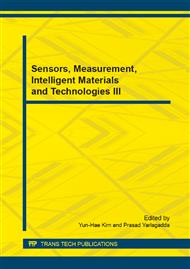[1]
Wenquan Han, Yourong Ren, Shaohua Zhao. Primary Usages of UAV Remote Sensing in Geological Disaster Monitoring and Rescuing[J]. Geospatial Information, 2011, 9(5): 6-8. (in Chinese).
Google Scholar
[2]
Biesemans J, Everaerts J, Lewyckyj N. PEGASUS: Remote Sensing from a HALE-UAV[C]. ASPRS Annual Convention. (2005).
Google Scholar
[3]
Vincent g. ambrosia S. Unconventional Airborne Platforms for Disaster Remote Sensing Support[J]. Geoscience and Remote sensing, 2009: 91-114.
DOI: 10.5772/8302
Google Scholar
[4]
Wei Jin , Hongli Ge , Huaqiang Du , Xiaojun Xu. A Review on Unmanned Aerial Vehicle Remote Sensing and Its Application[J]. Remote Sensing Information, 2009, 01: 88-92. (in Chinese).
Google Scholar
[5]
Ruisheng Ma, Shuqing Ma, Liping Wang,et al. Preliminary Experiment of Forest Fire Monitoring System on Unmanned Aerial Vehicle[J]. Meteorological Science and Technology, 2008, 36(1): 100-104. (in Chinese).
Google Scholar
[6]
Bodi Lu, Diwen Meng, Ming Lu ,et al. Application and Exploration of Unmanned Aerial Vehicle in Major Natural Disasters [J]. Journal of Catastrophology, 2011, 26(4): 122-126. (in Chinese).
Google Scholar
[7]
Ke Zang, Yonghua Sun, Jing Li,et al. Application of Miniature Unmanned Aerial Vehicle Remote Sensing System to Wenchuan Earthquake[J]. Journal of Natural Disasters, 2010, 19(3): 162-166. (in Chinese).
Google Scholar
[8]
Yun Li, Wei Xu, Wei Wu. Application Research on Aviation Remote Sensing UAV for Disaster Monitoring[J]. Journal of Catastrophology, 2011, 26(1): 138-143. (in Chinese).
Google Scholar
[9]
Tianjie Lei, Changchun Li, Xiaoying He. Application of aerial remote sensing of pilotless aircraft to disaster emergency rescue[J]. Journal of Natural Disasters, 2011, 20(1): 178-183. (in Chinese).
Google Scholar
[10]
Lunji Ma, Ruisheng Ma, Zonggui Lin, et al. Preliminary application of mini-UAV in Remote Sensing[J]. Journal of Guangxi Meteorology , 2005, 26(S1): 180-181. (in Chinese).
Google Scholar
[11]
Chengxiao Fan, Jun Han, Zhijun Xiong,et al. Application and Status of Unmanned Aerial Vehicle Remote Sensing Technology[J]. Science of Surveying and Mapping, 2009, 34(5): 214-215.
Google Scholar
[12]
Zhe Li, Yukun Zhang, Yan Li. The Application of UAV on Disaster Prevention and Reduction in the Field of Architecture[J]. New Architecture, 2009, 01: 136-139. (in Chinese).
Google Scholar
[13]
Hongjiang Zhao, Xijun Jiang, Peng Yuan. A Summary of Airborne Infrared Forest Fire Detection System from U.S. Forest Service[J]. Forest Fire Prevention, 2010, 01: 52-57. (in Chinese).
Google Scholar
[14]
Deren Li, Ming Li. Research Advance and Application Prospect of Unmanned Aerial Vehicle Remote Sensing System[J]. Geomatics and Information Science of Wuhan University , 2014, 39(5): 505-513+540. (in Chinese).
Google Scholar
[15]
Lei Li, Tao Xiong, Xiangyang Hu,et al. Application Areas and Future of UAV[J]. Geospatial Information, 2010, 8(5): 7-9. (in Chinese).
Google Scholar
[16]
Colomina P. Molina. Unmanned Aerial Systems for Photogrammetry and Remote Sensing: A Review[J]. ISPRS Journal of Photogrammetry and Remote Sensing, 2014. 06, 92: 79-97.
DOI: 10.1016/j.isprsjprs.2014.02.013
Google Scholar
[17]
Heng Lu, Yongshu Li, Jing He,et al. Capture and Processing of Low Altitude Remote Sensing Images by UAV[J]. Engineering of Surveying and Mapping, 2011, 20(1): 51-54. (in Chinese).
Google Scholar
[18]
Yan Li. Image Processing of Unmanned Helicopter Remote Sensing[D]. Shanghai: East China Normal University, 2009: 1-8. (in Chinese).
Google Scholar
[19]
Shouyu Guo. Research on Earth Observation Coverage for Multiple Unmanned Rotorcraft[D]. Zhejiang : Zhejiang University, 2014: 3-9. (in Chinese).
Google Scholar
[20]
Xiaohong Zhang, Shengliang Zhao, Fengtian Chen. The Application of Agisoft Photoscan in UAV Aerial Photographic Image Data Processing[J]. Value Engineering , 2013, 20: 230-231. (in Chinese).
Google Scholar
[21]
Jun Li. Research on the Topographic Map Production and Three-dimensional Reconstruction Techniques Based on the Earthquake-stricken Area by UAV Remote Sensing[D]. Sichuan: Southwest Jiaotong University, 2012: 34-41. (in Chinese).
Google Scholar
[22]
Liucheng Yi . Unmanned Aerial Vehicle Remote Sensing Images and Digital Elevation Model of Three Dimension Visualization Research[D]. Hunan: Central South University, 2013: 19-27. (in Chinese).
Google Scholar


